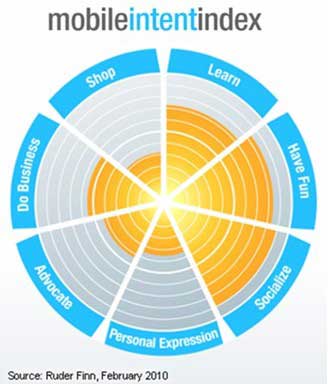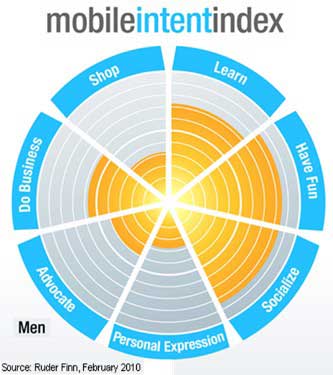Consumers spend an average of 2.7 hours on the mobile Internet each day—connecting socially, managing their personal finances, and even advocating for causes, according to a new survey from Ruder Finn.
Mobile Users Make Real-Time Social Connections
Socializing is the most popular activity among mobile Web consumers, the survey found: 91% use their mobile device to socialize, compared with 79% of desktop users.

Among those who use the mobile Web to connect socially, the top social activities performed include the following:
- Exchanging instant messages: 62%
- Forwarding emails: 58%
- Posting to social networking sites: 45%
- Connecting with others on social networking sites: 43%
- Forwarding content: 40%
- Forwarding photos: 38%
In addition, 61% of the mobile Internet users surveyed download mobile applications at least once a month, and 36% download applications from social networking sites at least once a month.
Below, other findings from Ruder Finn's Mobile Intent Index, February 2010.
Managing Finances With the Mobile Internet
Real-time access to business information is a key benefit of the mobile Web: Mobile phone users (62%) are 1.6 times more likely to go online to manage finances, compared with traditional desktop users (39%).
Among those who use the mobile Web to manage finances, the top activities performed include the following:
- Online banking: 46%
- Check bill/credit card status: 40%
- Read business blogs: 33%
Mobile phones are also used for advocacy: 67% of mobile phone consumers use the mobile Web to rally support for a cause, compared with 47% of traditional Web users. Nearly one-half (45%) of mobile phone consumers post cause-related opinions on social networking sites, and 40% forward content about a cause.
Less Education and Learning
Overall, mobile's transitory nature tends to discourage time-consuming pursuits like research and learning: 64% of mobile phone consumers go online for research purposes, compared with 94% of traditional Web users. Similarly, 64% of mobile phone consumers go online for educational purposes, compared with 96% of traditional Web users.
Intent of Mobile Consumers by Gender and Age

Below, some key differences between male and female mobile Web consumers:
- Men look at prices, but women buy: When shopping, men are more likely than women to use their mobile device to compare prices (47% vs. 30%), but women are more likely to purchase (40% vs. 30%).
- Women express themselves, whereas men do business: Women are more likely than men to personally express themselves (49% vs. 35%), while men are slightly more likely to conduct business (62% vs. 57%).
- Men want to get away: 79% of men use their mobile device to simply "escape," compared with 61% of women who do so.
- Women want to make others laugh: 70% of women use their mobile devices to entertain others, compared with 58% of men who do so.
Other findings:
- Young adults shop more: 44% of young adults (age 18-29) use their mobile devices to shop, compared with 35% of all adults.
- Seniors want to learn: 82% of seniors (age 60+) use their mobile phones to educate themselves, compared with 64% of all adults.
About the data: Ruder Finn's Mobile Intent Index is based on a representative and Census-balanced online study of 500 US adults age 18+ who "use their mobile device to go online or to access the Internet." The survey was conducted in November 2009 by RF Insights among respondents who belong to Western Wats' consumer panel, Opinion Outpost.



